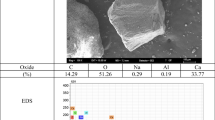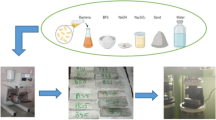Abstract
Little comparative research has been done on the efficiency of lithium additives to reduce the alkali–silica reaction (ASR) expansion. To reduce the ASR effects of reactive aggregate, different mortar bars were obtained by adding lithium additives (Li2SO4, LiNO3, Li2CO3, LiBr and LiF) to the mixing water by the following mass percentages of cement: 0%, 0.5%, 1%, 1.5%, 2%, 2.5% and 3%. The ASR expansions of the mortar bars at 2, 7 and 14 days were identified according to ASTM C 1260-14. The morphology of the specimens subject to the ASR effect was analysed using a scanning electron microscope, and their chemical composition was analysed by electron dispersion spectroscopy. Among all specimens, the lowest level of 14-day ASR expansion was obtained in mortar bars with 3% Li2CO3 additive.










Similar content being viewed by others
Abbreviations
- ASR:
-
alkali–silica reaction
- EDS:
-
electron dispersion spectroscopy
- Li2CO3 :
-
lithium carbonate
- Li2SO4 :
-
lithium sulphate
- LiBr:
-
lithium bromide
- LiF:
-
lithium fluoride
- LiNO3 :
-
lithium nitrate
- LiOH:
-
lithium hydroxide
- Na2Oeq :
-
alkali equivalent
- NaOH:
-
sodium hydroxide
- SEM:
-
scanning electron microscopy
- XRD:
-
X-ray diffraction
- XRF:
-
X-ray fluorescence spectrometry
References
Demir İ and Arslan M 2013 The mechanical and microstructural properties of Li2SO4, LiNO3, Li2CO3 and LiBr added mortars exposed to alkali–silica reaction. Constr. Build. Mater. 42: 64–77
Demir İ and Sevim Ö 2017 Effect of sulfate on cement mortars containing Li2SO4, LiNO3, Li2CO3 and LiBr. Constr. Build. Mater. 156: 46–55
Stanton T E 2008 Expansion of concrete through reaction between cement and aggregate. MI: Farmington Hills
Frohnsdorff G, Clifton J R and Brown P W 1978 History and status of standards relating to alkalies in hydraulic cements. In: Cement Standards-Evolution and Trends. West Conshohocken, PA: ASTM International
Hobbs D W 1988 Alkali–silica reaction in concrete. Michigan: Thomas Telford Publishing
Diamond S and Penko M 1992 Alkali–silica reaction processes: the conversion of cement alkalies to alkali hydroxide. In: Proceedings of the Symposium on Durability of Concrete ACI SP-131, American Concrete Institute, vol. 131, pp. 153–168
Helmuth R, Stark D, Diamond S and Moranville-Regourd M 1993 Alkali–silica reactivity: an overview of research. Washington, DC: National Research Council
Capra B and Bournazel J P 1995 Perspectives nouvelles pour la prise en compte des alcali-réactions dans le calcul des structures. Mater. Struct. 28(2): 71–73
Taylor G D 2014 Materials in construction: an ıntroduction. UK: Taylor & Francis
Ineson P R 1990 Siliceous components in aggregates. Cem. Concr. Compos. 12(3): 185–190
Wen H X 1998 Alkali-aggregate reaction in concrete. Lecture Notes. Hong Kong: Civil Engineering Department, Hong Kong University, pp. 1–55
Bagel L 1998 Strength and pore structure of ternary blended cement mortars containing blast furnace slag and silica fume. Cem. Concr. Res. 28(7): 1011–1022
Dongxue L, Xinhua F, Xuequan W and Mingshu T 1997 Durability study of steel slag cement. Cem. Concr. Res. 27(7): 983–987
Monteiro P J M, Wang K, Sposito G, Dos Santos M C and de Andrade W P 1997 Influence of mineral admixtures on the alkali–aggregate reaction. Cem. Concr. Res. 27(12): 1899–1909
Ramlochan T, Thomas M and Gruber K A 2000 The effect of metakaolin on alkali–silica reaction in concrete. Cem. Concr. Res. 30(3): 339–344
Malvar L J, Cline G D, Burke D F, Rollings R, Sherman T W and Greene J L 2002 Alkali–silica reaction mitigation: state of the art and recommendations. ACI Mater. J. 99(5): 480–489
Mazarei V, Trejo D, Ideker J H and Isgor O B 2017 Synergistic effects of ASR and fly ash on the corrosion characteristics of RC systems. Constr. Build. Mater. 153: 647–655
Souza L M, Polder R B and Çopuroğlu O 2017 Lithium migration in a two-chamber set-up as treatment against expansion due to alkali–silica reaction. Constr. Build. Mater. 134: 324–335
Leemann A, Bernard L, Alahrache S and Winnefeld F 2015 ASR prevention-effect of aluminum and lithium ions on the reaction products. Cem. Concr. Res. 76: 192–201
Ekolu S, Rakgosi G and Hooton D 2017 Long-term mitigating effect of lithium nitrate on delayed ettringite formation and ASR in concrete—microscopic analysis. Mater. Charact. 133: 165–175
Islam M S and Ghafoori N 2016 Experimental study and empirical modeling of lithium nitrate for alkali–silica reactivity. Constr. Build. Mater. 121: 717–726
Aquino W, Lange D A and Olek J 2001 The influence of metakaolin and silica fume on the chemistry of alkali–silica reaction products. Cem. Concr. Compos. 23(6): 485–493
Juenger M C G and Ostertag C P 2004 Alkali–silica reactivity of large silica fume-derived particles. Cem. Concr. Res. 34(8): 1389–1402
Ueda T, Baba Y and Nanasawa A 2013 Penetration of lithium into ASR-affected concrete due to electro-osmosis of lithium carbonate solution. Constr. Build. Mater. 39: 113–118
Feng X, Thomas M D A, Bremner T W, Folliard K J and Fournier B 2010 New observations on the mechanism of lithium nitrate against alkali silica reaction (ASR). Cem. Concr. Res. 40(1): 94–101
Kim T and Olek J 2016 The effects of lithium ions on chemical sequence of alkali–silica reaction. Cem. Concr. Res. 79: 159–168
Leemann A, Lörtscher L, Bernard L, Le Saout G, Lothenbach B and Espinosa-Marzal R M 2014 Mitigation of ASR by the use of LiNO3-characterization of the reaction products. Cem. Concr. Res. 59: 73–86
Stark D, Morgan B and Okamoto P 1993 Eliminating or minimizing alkali–silica reactivity. Washington, DC: National Research Council
Diamond S and Ong S 1992 The mechanisms of lithium effects on ASR. In: Proceedings of the 9th International Conference on Alkali–Aggregate Reaction. London: Concrete Society of UK, pp. 269–278
Mo X 2005 Laboratory study of LiOH in inhibiting alkali–silica reaction at 20°C: a contribution. Cem. Concr. Res. 35(3): 499–504
ASTM C1260-14 2014 Standard test method for potential alkali reactivity of aggregates (mortar-bar method), American Society of Testing and Materials. West Conshohocken, PA: ASTM International
Gautam B P and Panesar D K 2017 The effect of elevated conditioning temperature on the ASR expansion, cracking and properties of reactive Spratt aggregate concrete. Constr. Build. Mater. 140: 310–320
Morenon P, Multon S, Sellier A, Grimal E, Hamon F and Bourdarot E 2017 Impact of stresses and restraints on ASR expansion. Constr. Build. Mater. 140: 58–74
Li B, Baingam L, Kurumisawa K, Nawa T and XiaoZhou L 2018 Micro-mechanical modelling for the prediction of alkali–silica reaction (ASR) expansion: influence of curing temperature conditions. Constr. Build. Mater. 164: 554–569
Author information
Authors and Affiliations
Corresponding author
Rights and permissions
About this article
Cite this article
Demir, İ., Sevim, Ö. & Kalkan, İ. Microstructural properties of lithium-added cement mortars subjected to alkali–silica reactions. Sādhanā 43, 112 (2018). https://doi.org/10.1007/s12046-018-0901-3
Received:
Revised:
Accepted:
Published:
DOI: https://doi.org/10.1007/s12046-018-0901-3




